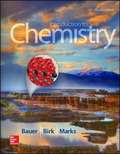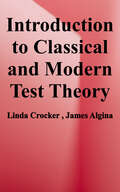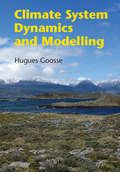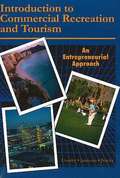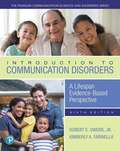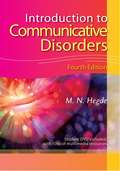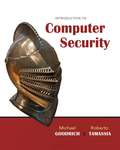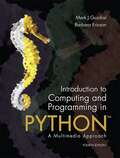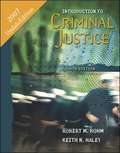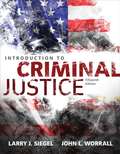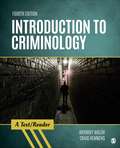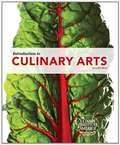- Table View
- List View
Introduction to Chemistry
by Richard C. Bauer James P. Birk Pamela S. MarksIntroduction to Chemistry, 4e by Bauer/Birk/Marks offers today's student a fresh perspective to the introduction of chemistry. This textbook offers a conceptual approach to chemistry by starting first with macroscopic phenomena, and then presenting the underlying microscopic detail. Each chapter opens with a real-life scenario that helps students connect abstract chemical concepts to their own lives. The math found in Introduction to Chemistry, 4e is introduced on a need-to-know basis, with "Math Toolboxes" in select chapters to help support the math skills required in that chapter.
Introduction to Chemistry 1: How Can I Smell Things from a Distance?
by Joseph S. Krajcik Brian J. ReiserNIMAC-sourced textbook
Introduction to Chemistry 2: How Can I Make New Stuff from Old Stuff? (IQWST)
by Joseph Krajcik Brian ReiserNIMAC-sourced textbook
Introduction to Chemistry interactive SCIENCE
by Michael J. Padilla Don Buckley Zipporah MillerMiddle Grade Science Textbook
Introduction to Circulating Atmospheres
by Alexander J. Dessler John T. Houghton Michael J. Rycroft Ian N. JamesThis book gives an account of the modern view of the global circulation of the atmosphere. It brings the observed nature of the circulation together with theories and simple models of the mechanisms which drive it. Early chapters concentrate on the classical view of the global circulation, on the processes which generate atmospheric motions and on the dynamical constraints which modify them. Later chapters develop more recent themes including low frequency variability and the circulations of other planetary atmospheres. The book will be of interest to advanced students and researchers who wish for an introduction to the subject before engaging with the original scientific literature. The book is copiously illustrated, and includes many results of diagnostic and modeling studies. Each chapter includes a set of problems and bibliographical notes.
Introduction to Classical and Modern Test Theory
by Linda Crocker James AlginaStudents of modern test theory must acquire a base of knowledge about classical psychometrics, but they must also be able to integrate new ideas into that framework of knowledge. <p><p>This text was written to help the reader attain these ends. The reader who hopes to find only a series of “cookbook” steps on how to carry out any specific process, uncluttered by technical discussion or statistical symbols, will be disappointed. <p><P>We recognize that “best” or “most recommended” procedures for any aspect of test development may change as new ideas and empirical findings are published. Thus it seems desirable for the students of test theory to acquire some practice in reading material that contains technical terms and symbols similar to those which will be encountered as they graduate from a textbook and begin to read the professional literature independently.
Introduction to Climate Dynamics and Climate Modeling
by P. Y. Barriat M. F. Loutre Goosse H. W. Lefebvre V. ZunzAn open source textbook. Bookshare demo title.
Introduction to Commercial Recreation and Tourism: An Entrepreneurial Approach (5th edition)
by John C. Crossley Lynn M. Jamieson Russell E. BrayleyIntroduction to Commercial Recreation and Tourism is a stepping stone to understanding the scope, characteristics, entrepreneurial strategies and management aspects of commercial recreation and tourism. Topics include the history of commercial recreation, definitions, economic applications, business start-up strategies, financing, marketing, operations management, and global trends. This edition also examines industry profiles for the travel, hospitality, and local commercial recreation industries. The Journal of Park and Recreation Administration viewed the past edition as a 'valuable addition to commercial recreation literature'.
Introduction to Communication Disorders: A Lifespan Evidence-Based Perspective
by Robert E. Owens Dale Evan Metz Kimberly A. FarinellaA clear, comprehensive introduction to communication sciences and disorders Introduction to Communication Disorders: A Lifespan Evidence-Based Perspective presents recent advances in the assessment and treatment of communication disorders in a highly readable manner. Each chapter is concise, yet comprehensive-striking a just right balance of information appropriate for introductory-level students. Readers gain a basic foundation in the areas of anatomy and physiology of speech and hearing, and an overview of the various disorders that affect voice, fluency, articulation, language, cognition, swallowing, and hearing across the lifespan. Updated case studies, evidence-based practice summary boxes, and new medically based photographs help students bridge the gap between theory and clinical application.
Introduction to Communicative Disorders (4th edition)
by M. N. HegdeIn this update of the 2001, 1995, and 1991 editions, Hegde (communication sciences and disorders, California State U. , Fresno) introduces the rapidly growing science of communication and profession of communicative disorders. Coverage includes a new chapter on literacy skills in children and the role of the speech-language pathologist in literacy intervention; profiles of speech-language pathologists and audiologists; and expanded material on audiology, audiology rehabilitation, and disorders of swallowing. The text includes study questions; information on professional education, organizations, and standards; a glossary.
Introduction to Comparative Politics: Political Challenges and Changing Agendas
by Mark Kesselman Joel Krieger William A. Joseph"Introduction to Comparative Politics offers accessible material for an introductory comparative politics course. Edited by a highly respected team of scholars, each of the text' s twelve country studies is written by an expert in the field. Four innovative themes, each with a specific focus, form the framework of the text: "The World of States, "Governing the Economy, "The Democratic Idea, and "The Politics of Collective Identities. A classification system focuses on levels of democracy, including established, transitional, and non-democracies. A chapter on the United States follows the same lines of comparison as those on other countries. Every chapter includes four to six sidebars, which focus on different subjects, including leaders, citizen action, institutional intricacies, current challenges, and global connections.
Introduction to Comparative Politics: Political Challenges and Changing Agendas
by Mark Kesselman Joel Krieger William A. JosephNIMAC-sourced textbook
Introduction to Comparative Politics: Political Challenges and Changing Agendas, AP* Edition
by Mark Kesselman Joel Krieger William A. JosephNIMAC-sourced textbook
Introduction to Computer Security
by Roberto Tamassia Michael T. GoodrichThis book is intended to provide an introduction to general principles of computer security from an applied viewpoint, common cyberattacks, including viruses, worms, password crackers, keystroke loggers, denial-of-service, DNS cache poisoning, port scanning, spoofing, and phishing.
Introduction to Computers and Information Technology
by Pearson Learning Solutions StaffIntroduction to Computers and Information Technology teaches essential computer technology concepts and skills. This text helps student build a concrete understanding of how computers work and how various types of computing devices and accessories are used in school, work, and at home. The book consists of three principle sections: Computing Fundamental explores hardware and software basics, input and output devices, storage, and operating systems. Applications teaches introductory skills in word processing, spreadsheets, database, presentation programs, and mutlimedia. Communications and Networks covers the latest in communications devices including smart phones and personal digital assistants as well as the network technology they run on.
Introduction to Computing and Programming In Python: A Multimedia Approach
by Barbara Ericson Mark GuzdialThis book is a uniquely researched and up-to-date volume that is widely recognized for its successful introduction to the subject of Media Computation. Emphasizing creativity, classroom interaction, and in-class programming examples, the book takes a bold and unique approach to computation that engages students and applies the subject matter to the relevancy of digital media. <p><p> The Fourth Edition teaches students to program in an effort to communicate via social computing outlets, providing a unique approach that serves the interests of a broad range of students. Key Topics: Introduction to Computer Science and Media Computation; Introduction to Programming; Creating and Modifying Text; Modifying Pictures Using Loops; Picture Techniques with Selection; Modifying Pixels by Position; Modifying Sounds Using Loops; Modifying Samples in a Range; Making Sounds by Combining Pieces; Building Bigger Programs; Manipulating Text with Methods and Files; Advanced Text Techniques: Web and Information; Making Text for the Web; Creating and Modifying Movies; Speed; Functional Programming; Object Oriented Programming. <p><p> This book is useful for anyone interested in learning computer programming.
Introduction to Contemporary Special Education: New Horizons
by Deborah Smith Naomi Tyler Kimberly SkowIntroduction to Contemporary Special Education: New Horizons presents an introduction to the professional practices, trends, and research that define contemporary special education while also conveying the diversity and excitement of this changing field.
Introduction to Contracts, Sales and Product Liability
by Jethro K. Lieberman Don Mayer Daniel M. Warner George J. SiedelMayer, Warner, Siedel and Lieberman's Introduction to Contracts, Sales and Product Liability is an up-to-date textbook that includes legal issues that are covered in an introductory business law course. The text is organized to permit instructors to tailor the materials to their particular approach. The authors take special care to engage students by relating law to everyday events with their clear, concise and readable style.
Introduction to Cosmology
by Barbara RydenThis second edition of Introduction to Cosmology is an exciting update of an award-winning textbook. It is aimed primarily at advanced undergraduate students in physics and astronomy, but is also useful as a supplementary text at higher levels. It explains modern cosmological concepts, such as dark energy, in the context of the Big Bang theory. Its clear, lucid writing style, with a wealth of useful everyday analogies, makes it exceptionally engaging. Emphasis is placed on the links between theoretical concepts of cosmology and the observable properties of the universe, building deeper physical insights in the reader. The second edition includes recent observational results, fuller descriptions of special and general relativity, expanded discussions of dark energy, and a new chapter on baryonic matter that makes up stars and galaxies. It is an ideal textbook for the era of precision cosmology in the accelerating universe. Written in an engaging style, using clear explanations and analogies to help students connect cosmology to everyday life Fits well to introductory cosmology courses, without requiring advanced mathematics or any prior study of astronomy Includes creative end-of-chapter problems that have been class-tested on students, with an instructor's manual featuring solutions available via www.cambridge.org/cosmology
Introduction to Criminal Justice (4th Edition Update)
by Robert M. Bohm Keith N. HaleyIntroduction to Criminal Justice, Fourth Edition update is not just for students interested in pursuing a career in criminal justice. It is also for students who simply want to learn more about this important social institution, which is vital to a free and democratic society. All citizens need to know their legal rights and responsibilities.
Introduction to Criminal Justice, Fifteenth Edition
by Larry J. Siegel John L. WorrallINTRODUCTION TO CRIMINAL JUSTICE, Fifteenth Edition, gives readers an exciting behind-the-scenes look at the workings of the police, courts, and correctional systems while equipping them with a solid understanding of criminal justice concepts. With its objective presentation and to-the-point writing style, the text effectively guides readers through the intricate workings of the processes of justice as well as key policy issues. The book also includes an emphasis on today's criminal justice careers, offering insights from numerous professionals on the rewards and realities of their jobs.
Introduction to Criminology: A Text/Reader
by Craig Hemmens Anthony WalshIntroduction to Criminology: A Text/Reader, Fourth Edition offers students a unique, comprehensive, interdisciplinary introduction to the study of criminology. Anthony Walsh and Craig Hemmens provide the best of both worlds—a brief, authored text with carefully selected and edited accompanying readings. Covering both classic and contemporary research in criminology, each reading shows students how to use current research to better understand criminal behavior. Students also gain an interdisciplinary perspective of crime and criminality by exploring the latest theories, concepts, and research from sociology, psychology, genetics, evolutionary biology, and the neurosciences.
Introduction to Culinary Arts
by Jerry Gleason Institute of America Culinary Art StaffIntroduction to Culinary Arts, Second Edition, covers everything from culinary theory and management to sanitation and safety to nutrition and food science to culinary and baking techniques, instilling practical knowledge and skills that students can apply throughout their career.
